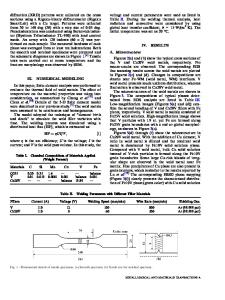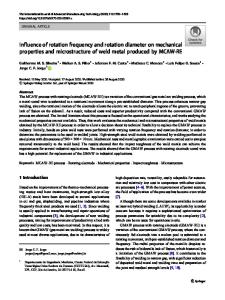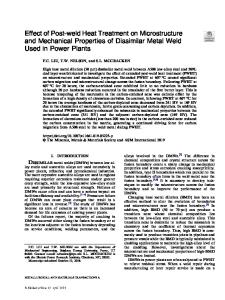Influence of high-temperature exposure on the microstructure and mechanical properties of dissimilar metal welds between
- PDF / 911,163 Bytes
- 12 Pages / 612 x 792 pts (letter) Page_size
- 19 Downloads / 335 Views
I. INTRODUCTION
BOILERS and piping in power generating plants are increasingly designed to operate under high-temperature and high-pressure conditions. For reasons of economy, ferritic steels are used in the lower temperature segments and the more oxidation- and creep-resistant austenitic stainless steels in the more arduous zones of higher temperature. The use of ferritic steels in fast breeder nuclear reactors is additionally justified by their resistance to stress corrosion cracking and to corrosion in caustic media. This demands the production of dissimilar metal welds between ferritic and austenitic stainless steel tubing, thus providing a compromise between the limiting operating temperatures for the low-alloy grades and the high cost of the austenitic stainless steels. It has been known for some time that these dissimilar metal welds fabricated with austenitic stainless steel consumables are a potential source of problems during high-temperature service exposure:[1,2,3] thermally induced cyclic stresses resulting from the difference in coefficients of thermal expansion (CTE) between the ferritic and austenitic steels, migration of carbon to the stainless steel resulting in a carbon-denuded region in the ferritic steel heat-affected zone (HAZ), and preferential stress oxidation at the weld metal/ferritic steel interface leading to the formation of oxide notches. In order M. SIREESHA, formerly with the Indian Institute of Technology, is with the Department of Chemical and Materials Engineering, San Jose State University, College of Engineering, San Jose, CA. SHAJU K. ALBERT, Scientific Officer, is with the Materials Joining Section, Indira Gandhi Centre for Atomic Research, Kalpakkam 603 102, India. S. SUNDARESAN, Professor and Emeritus Fellow, is with the Indian Institute of Technology, Chennai-600 036, India. Contact e-mail: [email protected] Manuscript submitted August 28, 2002. METALLURGICAL AND MATERIALS TRANSACTIONS A
to overcome these problems, nickel-base filler metals began to be used instead of austenitic stainless steel: this reduces the magnitude of the thermal stresses and decreases the extent of carbon migration from the ferritic steel into the weld metal because of the decreased carbon activity gradient and the low diffusivity of carbon in the nickel-base alloy.[3] Although considerable improvement in performance has been achieved with nickel-base filler materials, several failures have been reported even with these joints,[4–7] which are believed to occur by nucleation and propagation of creep-fatigue cracks along an array of carbide particles close to the ferritic steel/weld metal fusion boundary.[6] Another approach for improving the life of the transition joints is to use a trimetallic configuration with an intermediate material having a CTE between those of the ferritic and austenitic steels. One such material is Alloy 800 (high nickel Incoloy) and King et al.[8] who suggested it have shown that a considerable reduction of cyclic thermal stress could result from its use. Alloy 800 has bee
Data Loading...











